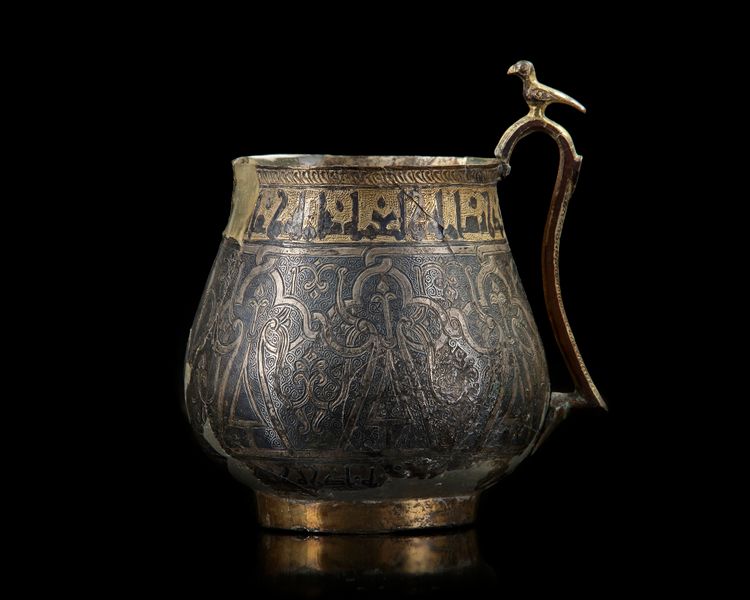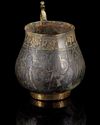A VERY RARE AND IMPORTANT EARLY ISLAMIC PARCEL-GILT CUP
The pyriform body with re-curved ear-form handle and bird thumb-piece, the main field of decoration incised and nielloed with a band of entwining arabesque and monumental palmette motifs in a frieze wrapped around the body, a gilt and nielloed epigraphic band running below the rim carries a minor band of guillouche ornament in gilt, handle and foot also gilt, restorations using transparent resin infill 13.6 cm. max. height.
PROVENANCE Private European collection
CATALOGUE NOTE inscriptions Around the neck: wa qudra shamila wa ni’ma kamila wa ‘a[fiya tamma wa d]awla ‘aliya wa … nasira ‘And perfect Power and complete [God’s] Grace and full Health and excellent Good-fortune and assisted …’
Around the lower body: baraka da’im[a] wa daw [la ‘aliya] wa … nasira wa qud[ra shamila] wa ni’ma [kamila] wa ‘afiya tamma wa surur ‘Perpetual Blessing, and excellent Good-fortune and assisted … and perfect Power and complete [God’s] Grace and full Health and Joy’
This parcel-gilt and nielloed handled cup not only presents an extremely rare example of early Persian silverware, but it also displays a variety of decorative techniques, rendering it of both art-historical and academic importance. It can be closely compared with a jug in the Harari Collection, now in the L.A. Mayer Museum for Islamic Art in Jerusalem (Hasson 2000, p.41), first published in the Survey (Pope and Ackerman 1938-9, vol. VI, p.1349).
Even though the jug in the L.A. Mayer Museum for Islamic Art features a more bulbous body with a straight, slightly flared rim, the two pieces probably derive from a common model, possibly of Sassanian origin. Both objects resemble a jug in the Staatliche Museen, Berlin, also dated to the eleventh/twelfth century, whose shape resembles that of the L.A. Mayer Museum example, but with a handle crowned by a leopard like on the present jug on which a sculptural bird stands at the top of the handle (Pope and Ackerman 1938-9, vol. VI, p.1353). Whereas this jug features nielloed, incised and punched decoration, the jug in the Staatliche Museen, Berlin, appears to feature mainly embossed designs.
The inscriptions on the present jug confer a number of blessings and wishes of good fortune on an unidentified owner. Nonetheless, it is the intricate incised and nielloed decoration on the body of the piece which displays the technical mastery and sophistication of silver metalworkers of this period. The surface is articulated with a band of interlocking vegetal forms and palmettes against a dense ground of foliate scrolls. An element of playfulness is added to the composition with the appearance of stylised faces between these abstract shapes, a feature that can also be found in other media, such as carved wood and stucco of the period.








